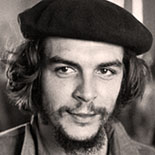 Ernesto “Che” Guevara (June 14, 1928 – October 9, 1967), commonly known as el Che or simply Che, was an Argentine Marxist revolutionary, physician, author, guerrilla leader, diplomat, and military theorist.
Ernesto “Che” Guevara (June 14, 1928 – October 9, 1967), commonly known as el Che or simply Che, was an Argentine Marxist revolutionary, physician, author, guerrilla leader, diplomat, and military theorist.
A major figure of the Cuban Revolution, his stylized visage has become a ubiquitous countercultural symbol of rebellion and global insignia in popular culture.
As a medical student, Guevara traveled throughout Latin America and was radically transformed by the poverty and alienation he witnessed. His observations during these trips led him to conclude that the region’s economic inequalities were a result of capitalism and imperialism, with the only remedy being world revolution. This belief prompted his involvement in Guatemala’s social reforms under President Jacobo Arbenz. Later, while living in Mexico City, he met Raúl and Fidel Castro, joined their 26th of July Movement, and sailed to Cuba with the intention of overthrowing U.S.-backed Cuban dictator Fulgencio Batista.
Following the Cuban Revolution, Guevara performed a number of key roles in the new government. These included reviewing the appeals for those convicted as war criminals, instituting land reform as minister of industries, helping spearhead a nationwide literacy campaign, serving as instructional director for Cuba’s armed forces, and traversing the globe on behalf of Cuban socialism.
Guevara was a prolific writer and diarist, composing a seminal manual on guerrilla warfare, along with a best-selling memoir about his youthful motorcycle journey across South America. Guevara left Cuba in 1965 to foment revolution in Bolivia, where he was captured by CIA-assisted Bolivian forces and executed. Time magazine named him one of the 100 most influential people of the 20th century.